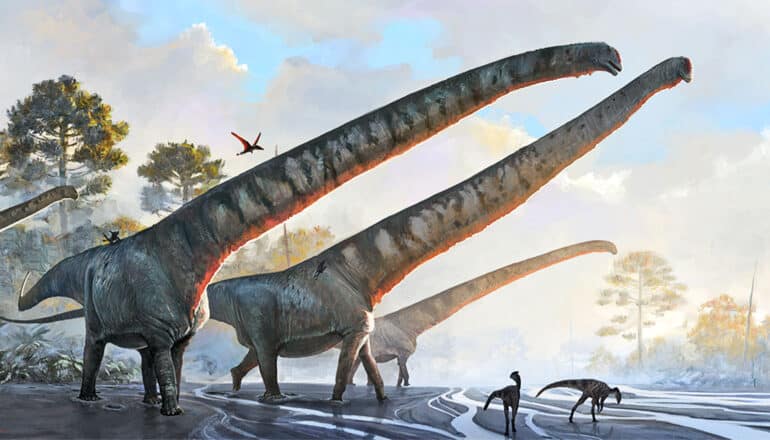
A new fossil analysis reveals a sauropod dinosaur with a record-breaking, nearly 50-foot-long neck.
With their long necks and formidable bodies, sauropod dinosaurs have captured people’s imaginations since the first relatively complete sauropod fossils were discovered in the United States in the late 1800s.
The new analysis of the Late Jurassic Chinese sauropod known as Mamenchisaurus sinocanadorum provides fresh insights on the evolution of the iconic sauropod body.
For sauropods, the long neck was the anatomical key to achieving large body size. To power such a large body, sauropods had to be efficient at gathering food, and that’s what a long neck was built for.
A sauropod could plant itself in one spot and hoover up surrounding vegetation, conserving energy while taking in tons of food. Having a long neck probably also allowed enormous sauropods to shed excess body heat by increasing their surface area, much like the ears of elephants.
This way of life—long neck-fueled, quadrupedal gigantism—is not one that is available to mammals or any other form of life today. The sauropod lifestyle was exceptionally successful: their lineage appeared early in dinosaur evolutionary history and persisted until the final days of the Mesozoic, when an asteroid wiped out all dinosaurs (except birds).
The researchers discovered Mamenchisaurus sinocanadorum in approximately 162-million-year-old rocks from the Xinjiang Uyghur Autonomous Region of northwest China in 1987. At approximately 15.1 meters (about 49.54 feet), the sauropod’s neck was more than six times longer than the necks of giraffes, the longest-necked animals alive today, and about 10 feet longer than a typical school bus.
The question of which sauropod had the longest neck is not straightforward. Because of their size, the largest sauropods tend to be some of the most poorly known: it’s very hard to bury such a large animal in sediment and thus safeguard it for fossilization.
Some fragmentary fossils suggest that other sauropod lineages independently evolved necks over 10 meters (32.8 feet) in length. However, poor preservation of these specimens and their closest relatives makes estimates of their neck length speculative.
Although Mamenchisaurus sinocanadorum is known only from a handful of bones from the neck and skull, the research team was able to reconstruct its evolutionary relationships and thus make comparisons to the unusually complete skeletons of its closest relatives, according to Andrew Moore, assistant professor in the department of anatomical sciences in the Renaissance School of Medicine at Stony Brook University.
This allowed them to conclude that Mamenchisaurus sinocanadorum had a neck approximately 15.1 meters (49.5 feet) long, the longest neck that can be confidently inferred for any known sauropod.
Their research stems from on-going work to comprehensively document the anatomical diversity and evolutionary history of the family Mamenchisauridae, a radiation of particularly long-necked sauropod dinosaurs that roamed East Asia and possibly other parts of the world from the Middle Jurassic to the Early Cretaceous (approximately 174–114 million years ago).
“All sauropods were big, but jaw-droppingly long necks didn’t evolve just once,” says Moore. “Mamenchisaurids are important because they pushed the limits on how long a neck can be, and were the first lineage of sauropods to do so. With a 15-meter-long neck, it looks like Mamenchisaurus sinocanadorum might be a record-holder—at least until something longer is discovered.”
How sauropods managed to evolve such long necks and hulking bodies without collapsing under their own weight remains something of a biomechanical puzzle. Remarkable specimens like Mamenchisaurus sinocanadorum provide some clues. For example, like their living cousins, birds, most sauropods had air-filled bones, which would have lightened their skeletons by removing heavy marrow and bone tissue.
Using computed-tomography (CT) scanning, Moore and colleagues found that the vertebrae of Mamenchisaurus sinocanadorum were mostly air (about 69–77% of their volume)—comparable to the lightly built skeletons of storks and other birds.
However, such featherweight skeletons would also be more prone to injury. To combat this, Mamenchisaurus sinocanadorum had 4-meter-long rod-like cervical ribs (about 13.1 feet), bony extensions of the vertebrae that created overlapping bundles of rods on either side of the neck. These bundles would have stiffened the neck of Mamenchisaurus sinocanadorum, increasing its stability and making it possible to build such a lightweight neck.
“Biomechanical studies of the mamenchisaurid neck suggest that it was elevated at only a relatively shallow angle above the horizontal (20-30°). However, even at this relatively shallow angle, the extreme length of the neck would still mean that the animal’s head could reach heights of around 7.5 to 10 meter above ground level [about 24.6 to 32.8 feet], facilitating feeding on tree foliage,” says coauthor Paul Upchurch, professor of paleobiology at the University College London.
“Mamenchisaurus sinocanadorum underscores how much we can learn about sauropod evolution even from very incomplete specimens,” adds coauthor Ye Yong, director of the Research Center of Jurassic Stratigraphy and Paleontology at the Zigong Dinosaur Museum in China’s Sichuan Province.
The study appears in the Journal of Systematic Palaeontology.
The United States National Science Foundation, the Royal Society of London, and the National Natural Science Foundation of China funded the work.
Source: Stony Brook University
The post Sauropod neck was 10 feet longer than a school bus appeared first on Futurity.
from Futurity https://ift.tt/K23AhSa
No comments:
Post a Comment